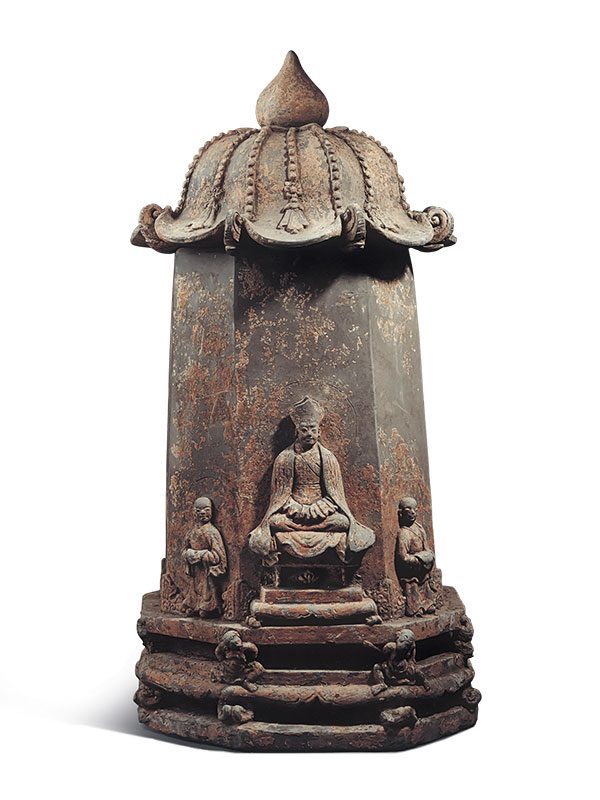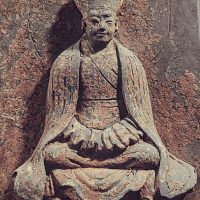Pottery reliquary jar
China, Southern Song to Yuan dynasty, 3th – 14th century AD
A pottery reliquary jar, the octagonal body tapering towards the top and supported on a two-tiered, galleried platform with claw feet, which in turn stands on a flat base. The jar is covered by a lid which is shaped as a large leaf with curled edges, from which eight mahakala trunks emerge. The cover is topped by a large onion-shaped finial, from which strings of beads run down, ending in a trefoil ornament. Moulded in prominent relief to the front of the jar is a Buddhist figure, sitting cross-legged on a tall throne. He wears pleated robes and a cape, and his head is crowned by a mitre-shaped hat. The face has a benign expression with a soft smile. On either side of him stands an acolyte, each dressed in a short tunic over a long robe and the arms folded in front of him. The faces are turned in the direction of the main figure. A further beaded edge runs along the bottom of the main body, interspersed with a foliate ornament to each corner. Directly underneath the throne are two caryatids, wearing loincloths. The grey pottery is partially covered in a pinkish pigment.
No other pottery reliquary jar of this type appears to have been published, and it is extremely rare to find tomb pieces in pottery with such obvious Buddhist iconography. Whilst there are obvious parallels with reliquaries in metal and stone, notably from Tang dynasty excavations[1], there do not appear to be many such pieces in later periods, although some Yuan and Ming period glazed architectural elements with Buddhist subject matter are recorded.[2] Stylistically, the figures relate to a group of four Yuan period bricks decorated in relief with dancers and musicians, which were unearthed in 1973 at Xifengfeng village in Henan province[3]. A comparison can also be made with Song and Yuan period glazed ceramics, such as a two-tiered yingqing pagoda base with niches containing figures of Buddha in the Metropolitan Museum[4], and the type of beaded ornament which sometimes forms part of the decoration on Qingbai porcelains.[5] The mitred headdress can be seen on a late 13th, early 14th century seated Guanyin in marble at the Art Institute of Chicago.[6]
Provenance:
Ben Janssens Oriental Art, February 2002
Private Collection, UK
1 In particular a stone shrine excavated in 1985 from the Qingshan temple site in Shaanxi province and included in the exhibition Gilded Dragons, Buried Treasures from China’s Golden Ages, catalogue by Carol Michaelson, London 1999, no. 99. There are also stylistic similarities to some of the Tang silver pieces from the well-known Famen temple hoard (1987), cf. a silver brazier included in the exhibition National Treasures, Gems of China’s Cultural Relics, Hong Kong 1997, no. 89.
2 See: Dated Chinese Antiquities 600 – 1650 by Sheila Riddell, London 1979, nos. 102-5.
3 See: China 5,000 years, Innovation and Transformation in the Arts, ed. Howard Rogers, New York 1997, no. 112.1
4 See: Chinese Art under the Mongols: The Yuan Dynasty (1279 – 1368) by Sherman E. Lee and Wai-Kam Ho, Cleveland 1968, no. 29
5 For Yuan period examples, see: Dated Qingbai Wares of The Song and Yuan Dynasties, ed. Peng Shifan, Hong Kong 1998, plates 98-99
6 See: Chinese Art under the Mongols: The Yuan Dynasty (1279 – 1368) by Sherman E. Lee and Wai-Kam Ho, Cleveland 1968, no. 1, p. 113
北宋/湖田窑花口划花盌
此盌刻花口,碗内划以牵牛花纹以及蓖纹,细圈足,糊米底,釉色白中微微泛青,为北宋晚期湖田窑瓷器釉面的经典发色。


